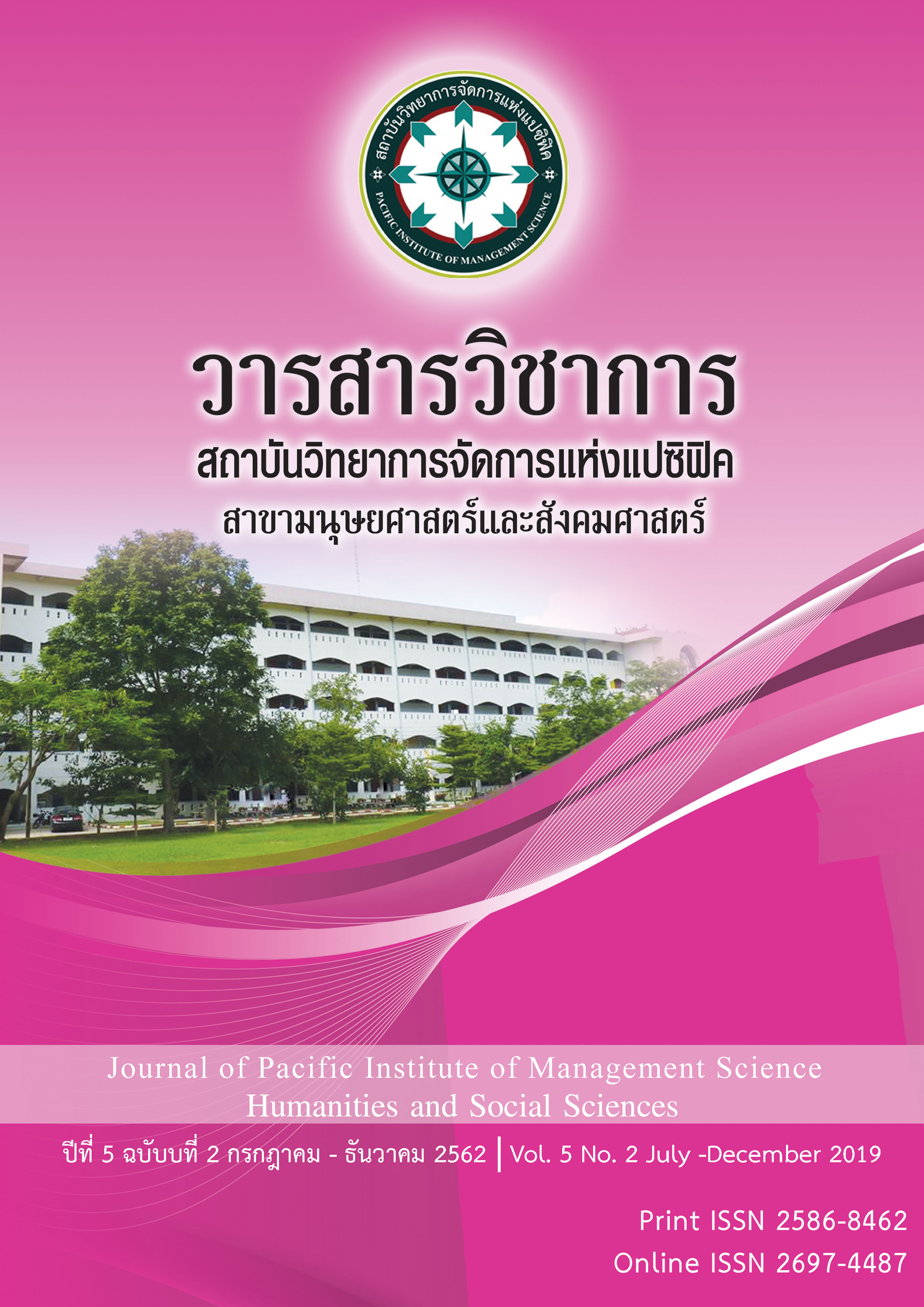Development of a relationship model of organizational support factors. Affecting adoption of digital marketing Membership of community enterprise in Bangkok
Keywords:
Organizational support, Digital marketing, Causal ModelAbstract
This research objectives were 1) to develop a causal relationship model illustrating the effects of organization support on adoption of digital marketing mediated through technology ability, utility perception and easy perception of community member enterprise in Bangkok 2) to validate the conformance between empirical evidence and the model; and 3) to examine the effect size of factors affecting adoption of digital marketing. The sample was composed of 590 people. The sample was selected by stratified random sampling. The research instruments were questionnaires on organizational support, technology ability, utility perception and easy perception which had the reliability coefficients between 0.807 to 0.921. Data analysis was executed with descriptive statistics and assessment of validity of the causal relationship model between organizational support and digital marketing adoption through statistical software.
Significant finding could be summarized as follows: The causal relationship model illustrating the effects of organizational support on digital marketing adoption mediated through technology ability, utility perception, and easy perception of community enterprise in bangkok. The validity assessment of the causal relationship model, conformed to the empirical evidence (χ 2 = 45.22; df = 35; p = . 115; GFI = .984; AGFI = .96; RMR = 0.022) , whereas the variables in the causal relationship model explained 65% of the variance of digital marketing adoption. The support variables from the organization had the maximum influence size of .62 and the direct influence variable was perceived ease, followed by perceived benefits. Administrators should support the organization to increase the capacity and operational capacity of digital marketing applications. Competing in the future channel expansion expanding customer base to become a strong enterprise community enterprise.
References
กระทรวงอุตสาหกรรม. (15 กุมภาพันธ์ 2561). มาตรการพิเศษการขับเคลื่อน SME สู่ยุค 4.0 . เข้าถึง ได้จาก http://www.industry.go.th/industry/index.php/th/2016-02-07-16-5426/smes-4-0/file
ดวงใจ ธรรมนิภานนท์ . (2557 ). กลยุทธ์การตลาดผลิตภณฑั ์ค วามงามผ่านช่องทาง การค้าแบบดิจิทัล. บัณฑิตศิกษา มหาวิทยาลัยเนชัน
ทิพวรรณ หล่อสุวรรณรัตน์. (2548). องค์กรแห่งความรู้: จากแนวคิดสู่การปฏิบัติ. พิมพ์ครั้งที่ 2. กรุงเทพฯ : แซท์โฟร์พริ้นติ้ง.
ธงพล พรหมสาขา ณ สกลนคร และอุทิศ สังขรัตน์. (2556). แนวทางการพัฒนาการ ดําเนินการของ วิสาหกิจชุมชนในเขตลุ่มทะเลสาบสงขลา. ปัตตานี: ภาควิชา สารัตถศึกษา คณะศิลปศาสตร์ มหาวิทยาลัยสงขลานครินท
นงลักษณ์ วิรัชชัย. (2542). โมเดลลิสเรล: สถิติวิเคราะห์สําหรับการวิจัย. กรุงเทพมหานคร: โรงพิมพ์แห่งจุฬาลงกรณ์มหาวิทยาลัย.
นาคเรือง ดุษฏีวัฒนยืนยง สุธิดา และ เลขาวิจิตร นุชนภา. (2560). ปัจจัยที่มีอิทธิพลต่อผลการ ดําเนินการของวิสาหกิจชุมชนจังหวัดยะลา. วารสารศรีนครินวิโรฒวิจัยและพัฒนา, 9, 69–75
บุษรา ประกอบธรรม. (2556). การศึกษาการยอมรับเครือข่ายสังคมออนไลน์ของนักศึกษา: กรณีศึกษา มหาวิทยาลัยกรุงเทพ. วารสารสุทธิปริทัศน์, 81.
บุญเรียง ขจรศิลป์. (2543). วิธีวิจัยทางการศึกษา (พิมพ์ครั้งที่ 5). กรุงเทพมหานคร: พี. เอ็น. การพิมพ์.
รชฏ ชัยสดมภ์.(2550). ความสัมพันธ์ระหว่างการรับรู้การสนับสนุนจากองค์การ พฤติกรรมการเป็น สมาชิกที่ดีขององค์การ และความผูกพันต่อองค์การ : กรณีศึกษาโรงงงานอุตสาหกรรมผลิด ชิ้นส่วนอิเลคทรอนิคส์. วิทยานิพนธ์ ศิลปศาสตรมหาบัณฑิต มหาวิทยาลัยธรรมศาสตร์. ระบบสารสนเทศวิสาหกิจชุมชน กองส่งเสริมวิสาหกิจชุมชน กรมส่งเสริมการเกษตร (14 มีนาคม 2561) . จํานวนสมาชิกวิสหกิจชุมชน. เข้าถึงจาก https://smce.doae.go.th/.
สุชาติ จรประดิษฐ์. (2557). อิทธิพลของการใช้แนวคิดเศรษฐกิจสร้างสรรค์ และคุณลักษณะของ ผู้ประกอบการ ที่มีต่อความส าเร็จทางการตลาดของสินค้าหนึ่งต าบลหนึ่งผลิตภัณฑ์ (OTOP) ระดับ 5 ดาว ใน ประเทศไทย. วารสารสุทธิปริทัศน์, 88
สุกัญญา อธิปนันต์. (2550). กลยุทธ์การพัฒนาวิสาหกิจชุมชนเพื่อการพึ่งพาตนเอง. กรุงเทพฯ: กรมส่งเสริม การเกษตร.
อรพรรณ บุลสถาพร. (2549). กลยุทธ์การตลาดส้มโอขาวแตงกวาภายใต้โครงการสินค้าหนึ่งตา บล หนึ่ง ผลิตภัณฑ์ จังหวัดชัยนาท.วิทยานิพนธ์ศิลปศาสตรมหาบัณฑิต, สาขายุทธศาสตร์การ พัฒนา, มหาวิทยาลัยราชภัฏนครสวรรค์.
อุทิศ สังขรัตน์.(2556).แนวทางการพัฒนาการดําเนินงานของวิสาหกิจชุมชนในเขตลุ่มทะเลสาบ สงขลา. วารสารวิชาการคณะมนุษยศาสตร์และสังคมศาสตร์ ปีที่ : 10 ฉบับที่ : 1 เลขหน้า : 97-122
Billy Kalemal, Oludayo Olugbara, & Ray Kekwaletswe. (2011). A Structural Equation Model of Student’s Priority for Selecting e-Learning Tools.
Chun-Mei CHOU, His-Chi HSIAO, Chien-Hua SHEN, & Su-Chang CHEN. (2010). Analysis of Factors in Technological and Vocation School Teachers’perceived Organozational Innovative Climate And Continues Use Of e-teaching: Using Computer self-efficacy as an intervening . TOJET: The Turkish Online Journal of Educational Technology, 9(4).
Davis. (1985). A technology acceptance model for empirically testing new end- user information systems: Theory and results, Unpublished Ph.D. dissertation,MIT Sloan School of Management, Cambridge, MA
Davis, F. D. (1989). Perceived usefulness, perceived ease of use, and user acceptance of information technology. MIS Quarterly, 13(3), 319-339 Davis, F. D., Bagozzi, R., & Warshaw, P. (1989). User acceptance of computer technology A comparision of two theoretical models. Management Science, 35,
Hassan M., Selim Ahmed. (2010). Hybrid E-Learning Acceptance Model: Learner Perceptions. Decision Sciences Journal of Innovative Education, 8(2).
Henretta.(2561). Internet Marketing . Retrieved from http://www.hostify.com/category/blogmarketing
Henretta (2554). ดิจิทัลเปลียนโลกทั้งใบ.... ได้อย่างไร. Retrieved from http://bangkokbiznews.com/home/details/business/ceoblogs/uraiporn/201107 15/400266/ดิจิทัลเปลี่ยนโลกทั้งใบอย่างไร.html Hostify.
Hsi-Chi Hsiao ,Ya-Ling Tu and Hsin-Nan Chung. (2012). Perceived Social Supports, Computer Self-Efficacy, And Computer Use Among High School Students. The Turkish Online Journal of Educational Technology, 11(2).
Hussi, T. (2004). Reconfiguring knowledge management – combining intellectual capital, intangible assets and knowledge creation. JOURNAL OF KNOWLEDGE MANAGEMENT.
Jung Yu Lai. (2009). How Reward, Computer Self-Efficacy, and Perceived Power Security Affect Knowledge Management Systems Success: An Empirical Investigation in High-Tech Companies. Journal of The American Society for Information Science and Technology, 60(2), 332-347.
Marakas, G. M., Yi, M. Y., & Johnson R. D. (1998). The multilevel and multifaceted character of Computer Self-Efficacy: Toward clarification of the construct and an integrative framework for research. Information Systems Research, 9(2), 126-163.
Markus Baer, & Michael Frese. (2003). Innovation is not enough: Climates for initiative and psychological safety, process innovations, and firm performance. Journal of Organizational Behavior, 24, 45-68
Newageagency (2561,Janury 23). สื่อดิจิทัลจ่อขึ้นเบอร์ 2 . Retrieved from https:// : newageagency.wordpress.com/2012/05/11/)
Park, S. Y. (2009). An Analysis of the Technology Acceptance Model in Understanding University Students' Behavioral Intention to Use e-Learning. Educational Technology & Society, 12(3), 150-162
Shintaro Okazaki, & Luiz Miguel Renda dos Santos. (2012). Understanding E-Learning Adoption in Brazil Major Determinants and Gender Effects. IRR ODL The international Review of Research in Open distance learning.
Wen-Kai K. Hsu and Show-Hui S. Huang(2014) Determinants of Computer Self- Efficacy—An Examination of Learning Motivations and Learning Environments. Journal of Educational Computing Research. ol 35, Issue 3, pp. 245 – 265
Ya-Yueh Shih (2016) The effect of computer self-efficacy on enterprise resource planning usage, Behaviour & Information Technology, 25:5, 407411, DOI: 10.1080/01449290500168103
Downloads
Published
Issue
Section
License
บทความที่ได้รับการตีพิมพ์เป็นลิขสิทธิ์ของ สถาบันวิทยาการจัดการแห่งแปซิฟิค
ข้อความที่ปรากฏในบทความแต่ละเรื่องในวารสารวิชาการเล่มนี้เป็นความคิดเห็นส่วนตัวของผู้เขียนแต่ละท่านไม่เกี่ยวข้องกับสถาบันวิทยาการจัดการแห่งแปซิฟิค และคณาจารย์ท่านอื่นๆในสถาบันฯ แต่อย่างใด ความรับผิดชอบองค์ประกอบทั้งหมดของบทความแต่ละเรื่องเป็นของผู้เขียนแต่ละท่าน หากมีความผิดพลาดใดๆ ผู้เขียนแต่ละท่านจะรับผิดชอบบทความของตนเองแต่ผู้เดียว







